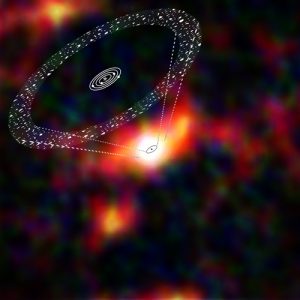| Basic Information | |
| What is this? | The star Gleise 581, which is surrounded by a disk of dust material |
| Where is it in the sky? | In the constellation of Libra |
| How big is it? | The debris disc stretches up to 60 times further from the star than the Earth is from the Sun |
| How far away is it? | Around 22 light years |
| What do the colours represent? | The redder material is cooler, while the yellow and white are warmer material closer to the star. The other red blobs are background galaxies |
Downloads
See this object in:
Herschel has discovered a vast dusty ring of material around the star Gliese 581, which also contains four relatively small planets. The planets have masses between 2 and 15 times that of the Earth, making the largest similar in mass to Neptune. The quantity of dust present is much higher than in our Solar System, implying that the lack of a massive Jupiter-like planet allows such debris discs to survive more easily.
Gliese 581 an M dwarf star and is much less massive than the Sun, having between a quarter and a third of the mass. This makes it much redder and cooler. Although the four known planets all orbit the star much closer than any planet in our Solar System, two of them are in the “Goldilocks zone” – a region where the temperature could allow liquid water to exist on a planet’s surface – though both are probably too massive to be rocky planets like the Earth.

Although Herschel cannot see the central star directly, the images can still be used to deduce the structure of the system. The planets orbit within a quarter of the Earth-Sun distance (called an astronomical unit, or “AU”), but the debris disc extends from approximately 25 to 60 AU. In the image on the right, a sketch of the debris disc and planet orbits are shown, though it is not to scale – the planet orbits would actually be much, much smaller on this scale. The other blobs in the image, to the right, upper-left and lower-right of the image, are not part of the planetary system, but rather are background galaxies that Herschel also sees.
Gliese 581 is one of a number of stars observed by the DEBRIS Herschel observing programme. These low-mass M-type dwarf stars are the most common stars in the Galaxy. Of three such stars with known planets, Gleise 581 was the only one to show any sign of a debris disc, and also the only one without a massive, Jupiter-like planet orbiting it.
The only other M-type star known to possess a debris disc is AU Microscopii, which is much younger at only around 12 million years old. With an age of 2 billion years, Gleise 581 also shows that these debris discs are not always dispersed by the radiation emmanating from the central star.
This connection between the relatively low planet mass and the presence of a debris disc has also been seen in Sun-like stars such as 61 Virginis, which was also observed by the DEBRIS programme.

